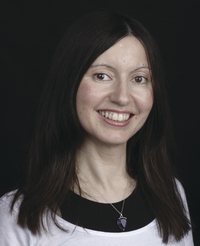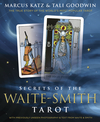An Interview with Marcus Katz
1. Your new book, Secrets of the Waite-Smith Tarot, is the fourth book in three years on which the two of you have collaborated—and you have two new oracle decks coming out this year, as well. From where do you draw your ideas?
Everyone looks for purpose in their life; in writing, we try and connect to a higher place and share this experience in our books. It sounds clichéd, and spiritually contrived, but it is how we feel—every book, every deck, is part of one story, the same story we all seek. In working with the esoteric tradition we remember what is important to us—and everything else follows. We try and teach and leave in our books a magical legacy, to which anyone can connect and join us in creating a good life. We were asked this online recently, and we pulled a tarot card in answer; it was the Empress, signifying perhaps the secret to productivity is to do what you enjoy and keep it as down-to-earth as possible.
We were asked this online recently, and we pulled a tarot card in answer; it was the Empress, signifying perhaps the secret to productivity is to do what you enjoy and keep it as down-to-earth as possible.
2. What is the collaborative writing process like?
We get asked this a lot, but it is still a mystery to us, and an ongoing adventure.
We often think about how Pamela Colman Smith and Arthur Edward Waite worked together, so briefly and powerfully, and how Frieda Harris and Aleister Crowley took five years to work on the Thoth Tarot. We have little record of the former and surviving letters from the latter. It seems that such collaborations always produce more than the sum of their parts, and yet remain a mystery in their magic.
We tend to always be doing four different things each at the same time, like pieces of a jig-saw that we cannot really see in advance. Sometimes pieces come together, sometimes we look at what we have both written and realize they are corner-pieces of something new.
3. The title of the book, Secrets of the Waite-Smith Tarot, refers to the tarot as "Waite-Smith" style as opposed to the ever-popular "Rider-Waite." Why do you make this distinction?
We really wanted to use a standard and modern format for the title, to show how our book recognizes equally both Waite and Smith.
The deck has not been associated primarily with the original publisher, Rider & Sons, for many years, so is a bit redundant. We also wanted to demonstrate that our book was different to what people expect and think, yet returns to the original two sources: Pamela and Arthur.
4. The book also includes new material from illustrator Pamela Colman Smith; where did you find this new material?
We tell this story in the book, like a Dan Brown novel made real: how sketches led to real places, how museum archives and private collectors provided material, and how we put the clues together to create a new story. There is even a stained glass window involved!
The material then started to provide itself to us, which is one of the real secrets of the book, how it wanted to be written, and the material revealed. We had sources from all over the world, including site visits to quaint parts of England and contacts with Japanese collectors.
5. The book's title refers to "secrets;" what other information about the deck and its origins do you divulge?
The main secret we divulge is how much Pamela used her everyday life to create the deck and the advice of Yeats to always create the "hill of heart's desire" in every piece of work. She left us another clue in an illustration that was entitled, "Look, and You Will See." We looked, and were surprised by how much information Pamela left in the card images themselves—information that has been missed for a century.
We demonstrate that the Minors were almost definitely Pamela's creation, and that over half of their design was based on her life at the time as well as Shakespeare. The "secrets" we reveal (more of which can be seen at www.waitesmithtarot.com) are totally new and have been described by Mary K. Greer as "astonishing."
6. What do you hope readers will take away from Secrets of the Waite-Smith Tarot?
We hope readers will be astonished at how many secrets were hidden in plain sight from so many people for so long. We know already from presentations and courses that have teased this book that readers fall in love with Pamela all over again, and see the cards—and the whole of tarot—in a totally different way.
In fact, in reading the book, we hope that readers will experience the magical thrill of having something they thought they knew totally turned on its head. This means that perhaps anything in life that appears fixed still has room for total transformation.

